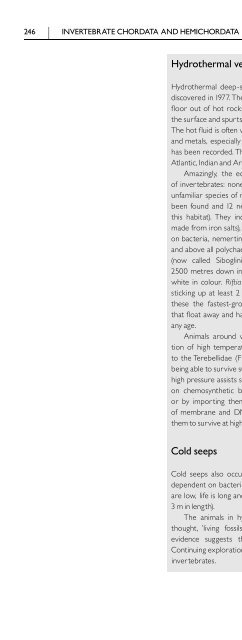An Introduction to the Invertebrates, Second Edition - tiera.ru
An Introduction to the Invertebrates, Second Edition - tiera.ru
An Introduction to the Invertebrates, Second Edition - tiera.ru
Create successful ePaper yourself
Turn your PDF publications into a flip-book with our unique Google optimized e-Paper software.
246 INVERTEBRATE CHORDATA AND HEMICHORDATAHydro<strong>the</strong>rmal ventsHydro<strong>the</strong>rmal deep-sea vents, mostly chimneys called ‘black smokers’, werediscovered in 1977. They are formed by underwater volcanos making a new seafloor out of hot rocks rich in minerals, and superheated water presses up <strong>to</strong><strong>the</strong> surface and spurts out, making vents with openings about10 cm in diameter.The hot fluid is often very acidic and has a high concentration of H 2 S, methaneand metals, especially iron. The temperature is usually about 65 °C, but 390 °Chas been recorded. These vents have been found <strong>to</strong> be common in <strong>the</strong> Pacific,Atlantic,Indian and Arctic oceans.Amazingly, <strong>the</strong> edges of <strong>the</strong>se smokers are inhabited by a large varietyof invertebrates: none of <strong>the</strong>se is a completely new kind of animal but most areunfamiliar species of recognisable groups. Over 500 new species have alreadybeen found and 12 new families; 90% of <strong>the</strong> species are endemic (unique <strong>to</strong>this habitat). They include gastropods (one species covers its foot in scalesmade from iron salts), bivalves, shrimps ga<strong>the</strong>ring near <strong>the</strong> vents, crabs feedingon bacteria, nemertines with symbiotic sulphur bacteria in <strong>the</strong>ir epidermal cellsand above all polychaete annelids, especially <strong>the</strong> vestimentiferan‘Pogonophora’(now called Siboglinidae). Some 200 000 of <strong>the</strong>se were found <strong>to</strong>ge<strong>the</strong>r2500 metres down in a black smoker in <strong>the</strong> Pacific, off Costa Rica, all red orwhite in colour. Riftia is <strong>the</strong> most striking and characteristic vestimentiferan,sticking up at least 2 m; <strong>the</strong> tube grows in length by 85 cm in a year, making<strong>the</strong>se <strong>the</strong> fastest-growing invertebrates known. Riftia produces yolky eggsthat float away and hatch in<strong>to</strong> yolky larvae; <strong>the</strong>re is never a mouth or a gut atany age.<strong>An</strong>imals around vents are zoned horizontally, according <strong>to</strong> <strong>the</strong>ir <strong>to</strong>lerationof high temperatures. The Alvinellidae, a new polychaete family related<strong>to</strong> <strong>the</strong> Terebellidae (Figure 9.6c), are common on <strong>the</strong> sides of black smokers,being able <strong>to</strong> survive sustained temperatures of 50 °C at <strong>the</strong> pressure prevailing:high pressure assists survival at high temperatures. All <strong>the</strong> vent animals dependon chemosyn<strong>the</strong>tic bacteria, by filtering <strong>the</strong>m, farming <strong>the</strong>m and grazing,or by importing <strong>the</strong>m as symbionts. They all have many special adaptations,of membrane and DNA st<strong>ru</strong>cture and blood and enzyme function, enabling<strong>the</strong>m <strong>to</strong> survive at high temperatures.Cold seepsCold seeps also occur at similar depths, with surprisingly similar fauna, alsodependent on bacteria metabolising sulphur and methane. Here temperaturesare low, life is long and growth is slow (a bivalve takes 170 250 years <strong>to</strong> reach3minlength).The animals in hydro<strong>the</strong>rmal vents and cold seeps are not, as at firstthought, ‘living fossils’, sheltered survivors from earlier epochs. Molecularevidence suggests that most of <strong>the</strong>se animals arose relatively recently.Continuing exploration of <strong>the</strong>se habitats is revealing more and more remarkableinvertebrates.











